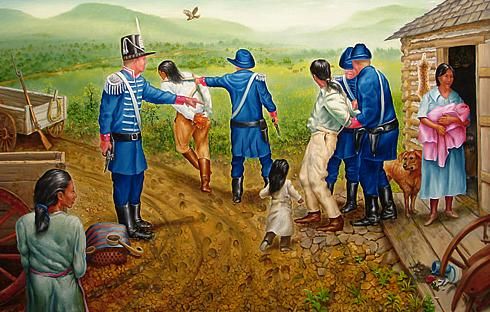Native Americans suffered and were forcibly removed from their homes, and the Trail of Tears is a painful reminder of this. With thousands of Native Americans being forcibly removed from their native lands during this forced migration that lasted from the early to mid-19th century, their communities suffered immense suffering and long-lasting effects.
This article delves into the origins, execution, and significant effects of the Trail of Tears, shedding light on its profound impact on Native Americans.
Origins of the Trail of Tears:
The Indian Removal Act of 1830, which President Andrew Jackson signed into law, is where the Trail of Tears originated. This legislation empowered the federal government to negotiate treaties with Native American tribes, facilitating their removal from their homelands in the southeastern United States to territories west of the Mississippi River. Ostensibly driven by a desire to accommodate white settlers and expand agricultural opportunities, the Indian Removal Act set the stage for the forced displacement of indigenous peoples on an unprecedented scale.
Execution of the Trail of Tears:
A series of forced marches known as the Trail of Tears, which resulted from the enforcement of the Indian Removal Act, forced the relocation of various Native American tribes, including the Cherokee, Choctaw, Chickasaw, Muscogee (Creek), and Seminole nations. The most well-known of these marches took place in 1838 when over 15,000 Cherokee people were forced to march from their homes in Georgia, Tennessee, and North Carolina to the Indian Territory, which is now Oklahoma. Appalling conditions, such as malnutrition, exposure to inclement weather, and sickness, characterized these excursions under the control of federal troops. Thousands of people died along the road, tragically attesting to the cruelty and contempt for human life that were inherent in this forced transfer.
Consequences on Indigenous Communities:
Generations after generation, the Trail of Tears’ effects continued to have a significant and long-lasting effect on American Indian communities. The loss of their ancestral territories signified an alteration in the tribes’ spiritual ties to the land and cultural continuity. They were forced to start again in strange places, and they encountered great difficulties adjusting to their new surroundings and maintaining their customs. Additionally, the trauma caused by the Trail of Tears extended to later generations, manifesting as social, economic, and health disparities that still torment indigenous communities today.
Cultural Disintegration:
Indigenous cultures and customs were rapidly lost as a result of the Trail of Tears, which forcibly relocated Native American tribes. After being uprooted from their native territories and societies, a great deal of indigenous peoples felt deeply uprooted and cut off from their cultural legacy. In the face of assimilationist pressures, tribes struggled to preserve their cultural identity, putting traditional customs, languages, and knowledge systems in jeopardy. Furthermore, the trauma of relocation exacerbated social problems already present in indigenous communities, fostering cycles of mental illness, drug misuse, and poverty.
Legal and Political Ramifications:
Important political and legal repercussions of the Trail of Tears also shaped the federal government’s relationship with America’s indigenous peoples. Native American tribes’ forced relocation served as a stark reminder of how eager the federal government was to put white settlers’ interests ahead of indigenous peoples’ rights and sovereignty. Current discussions over land rights, aboriginal sovereignty, and the fulfillment of federal trust obligations are still influenced by this history of expropriation and disdain for treaty obligations. Along with this, the Trail of Tears sparked movements for political empowerment, cultural renewal, and land restitution among Native American tribes, as well as indigenous resistance and advocacy for justice.
Conclusion:
The Trail of Tears is still a sorrowful reminder of the ongoing wrongs done to Native Americans in the United States. This forced relocation is the perfect example of the systematic oppression and dispossession that have defined the relationship between the federal government and Native American tribes, from its beginnings in the Indian Removal Act to its terrible effects on Indigenous people. It is important to recognize the ongoing effects of the Trail of Tears and work for healing, reconciliation, and justice for indigenous peoples in America as we face the legacies of colonialism and conquest.

